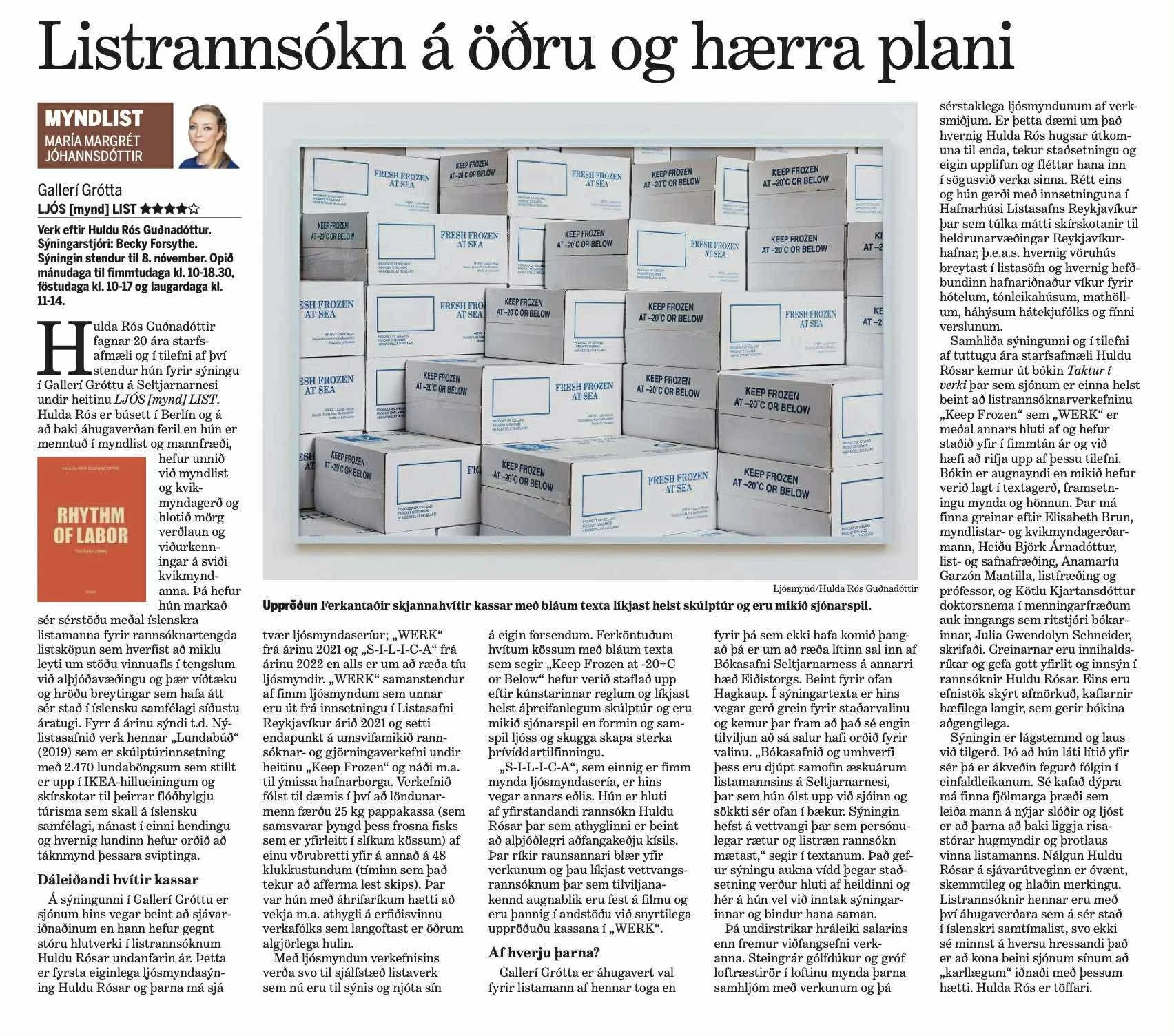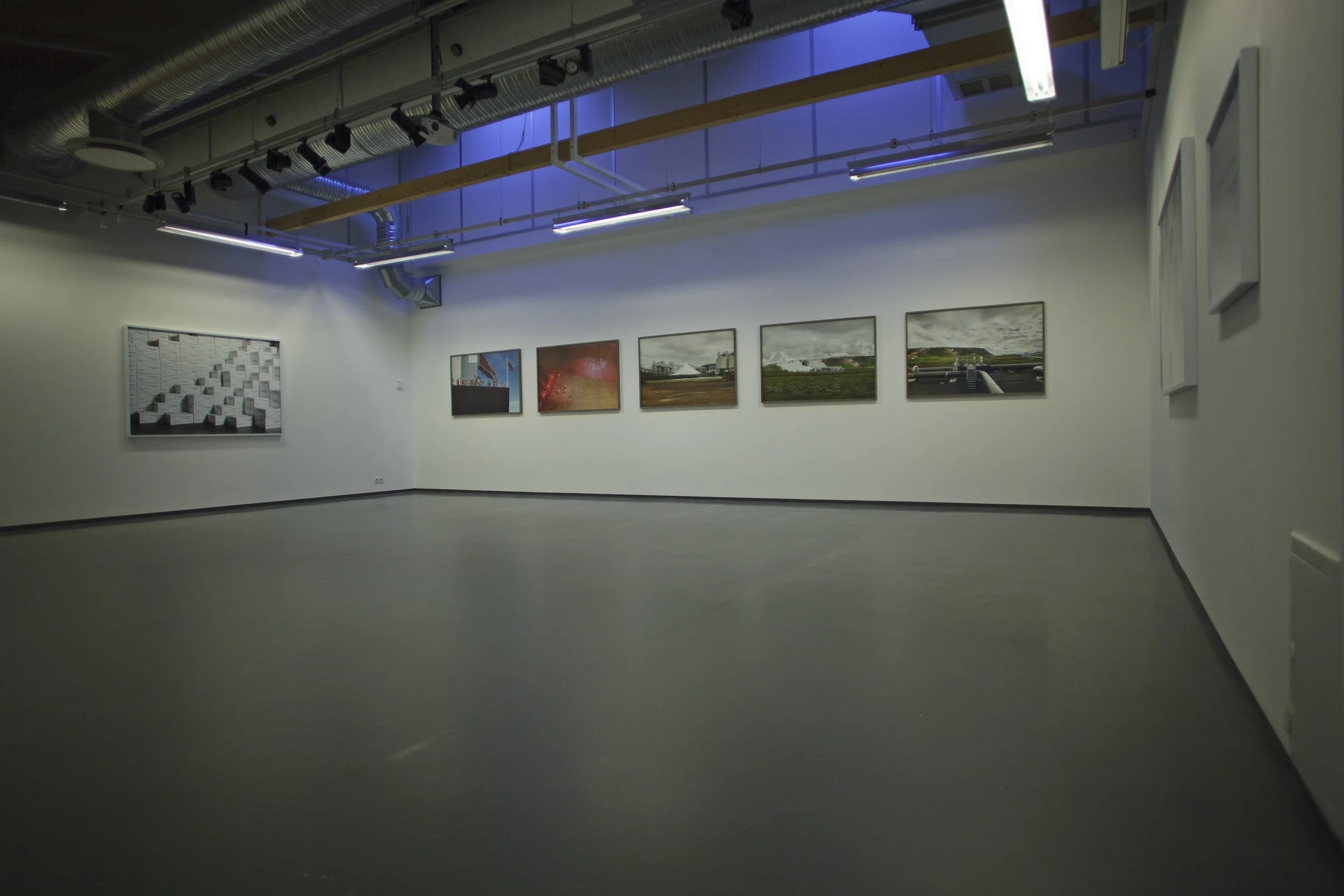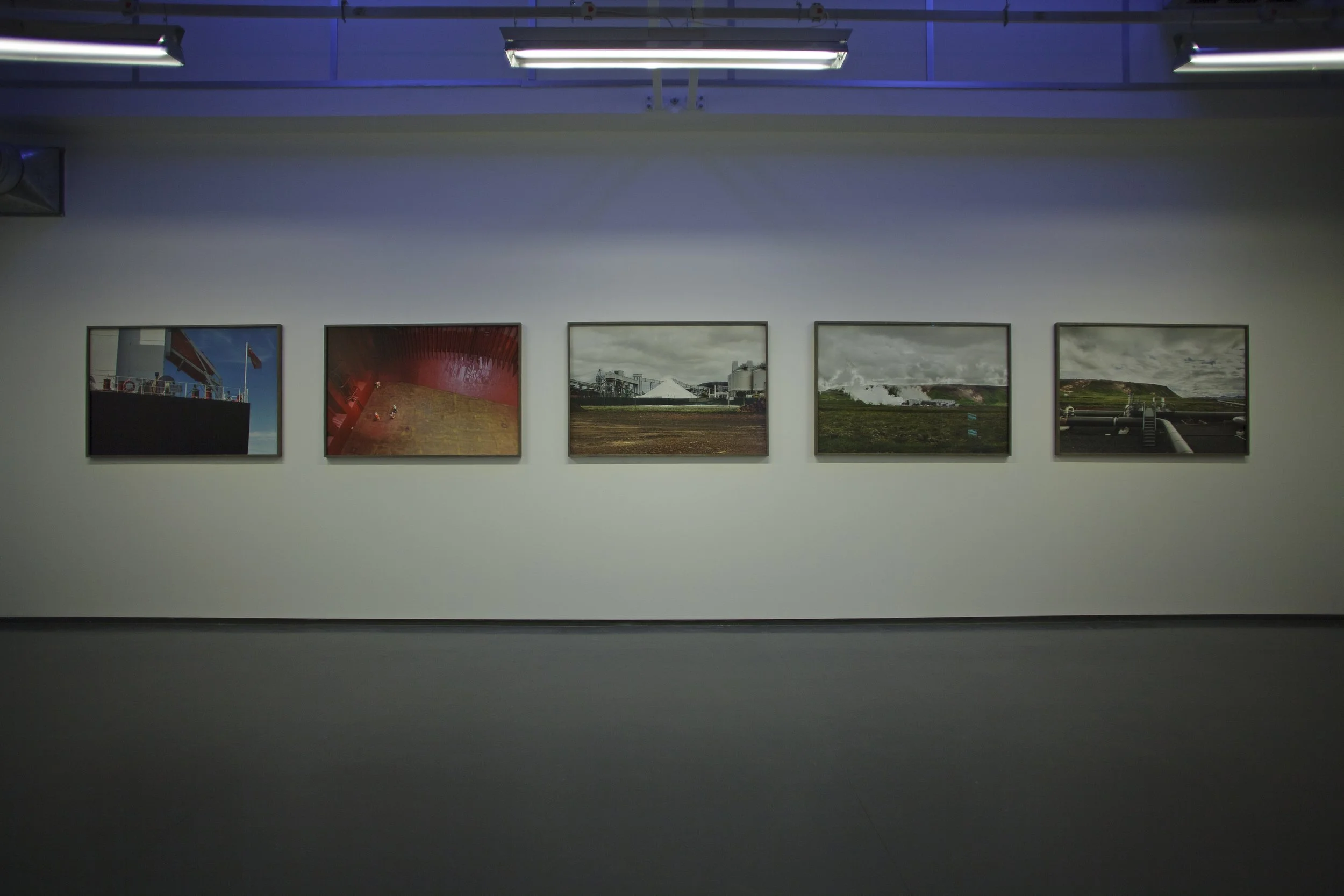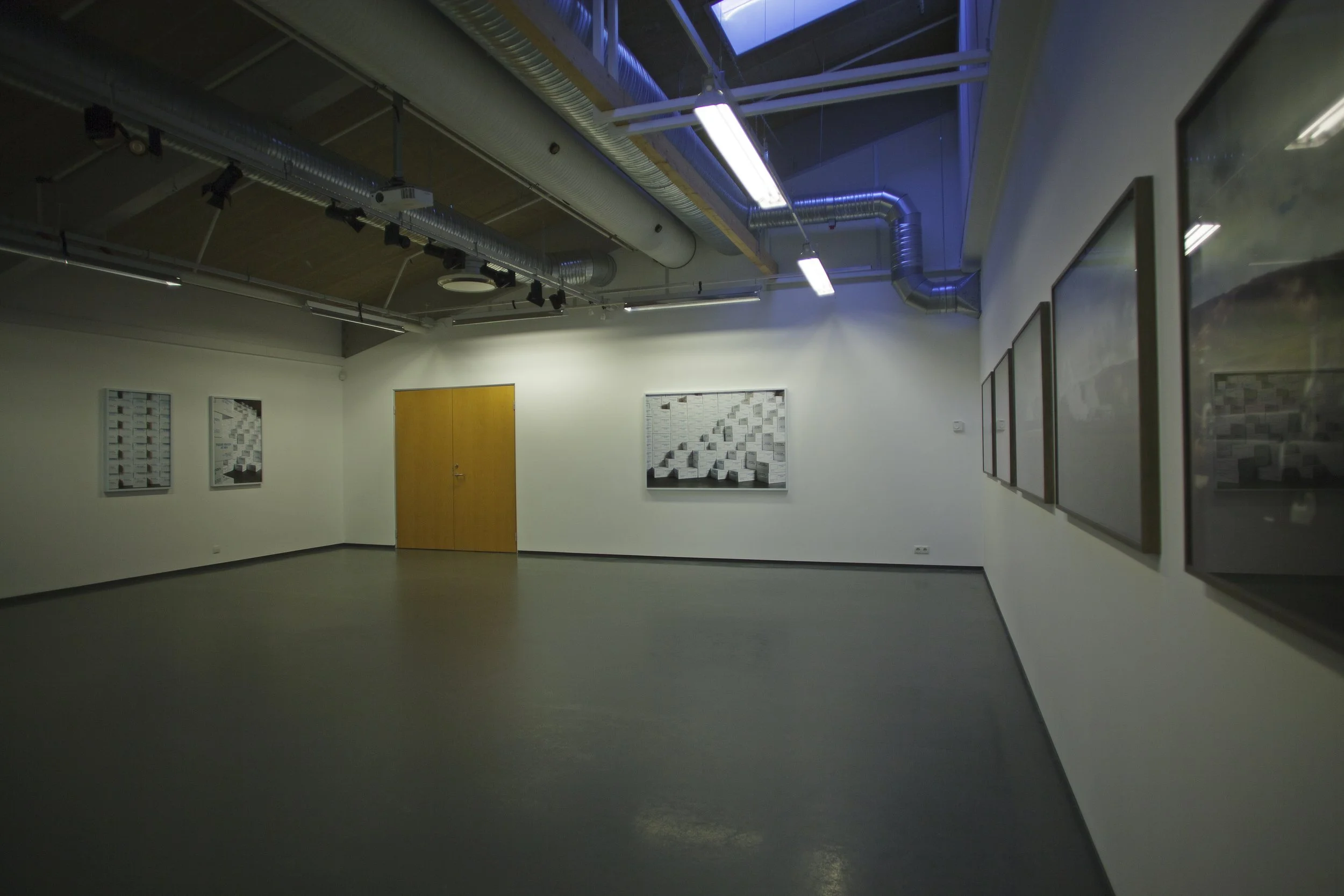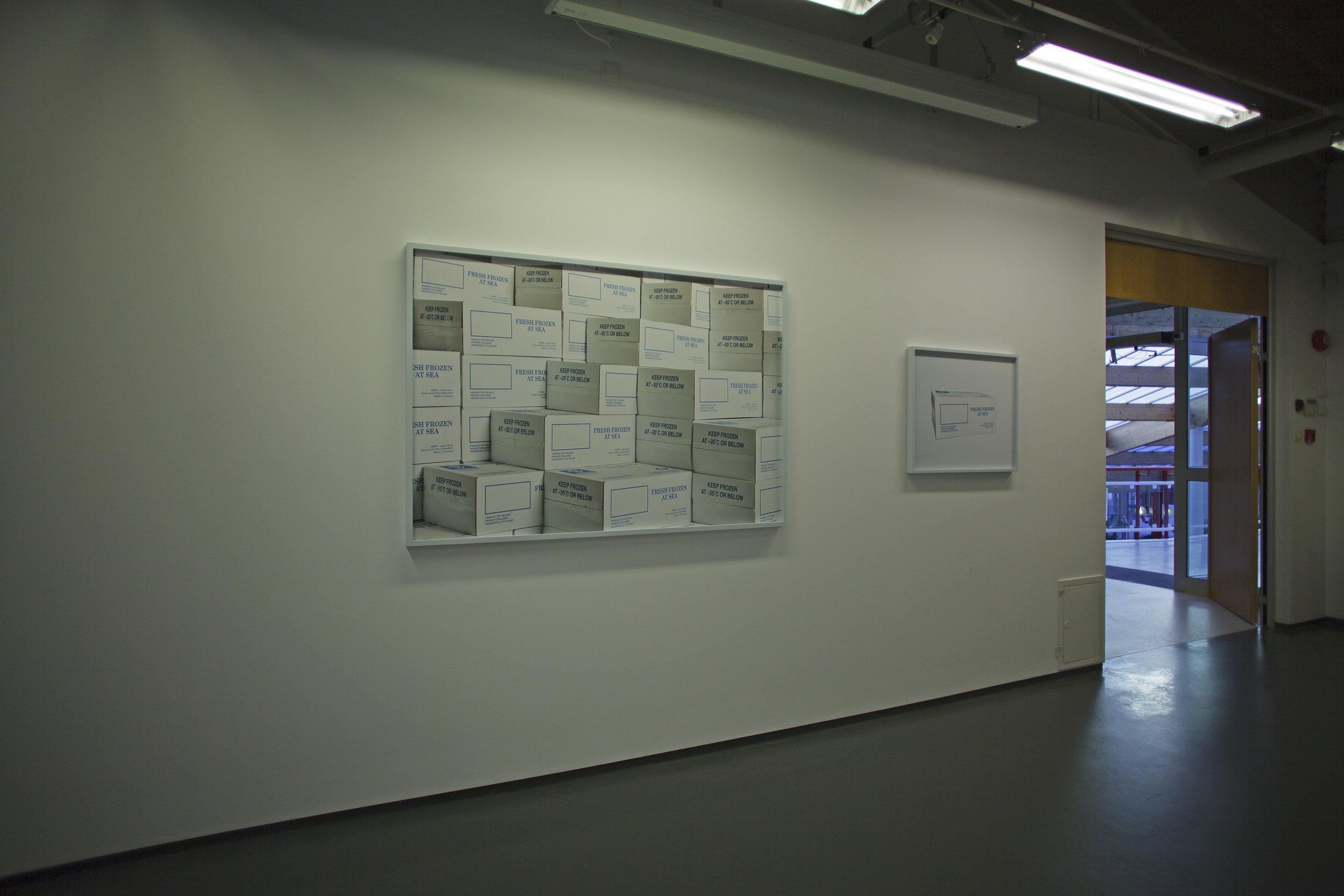Curated by Becky Forsythe at Gallerí Grótta in Reykjavík, Iceland.
Review by María Margrét Jóhannsdóttir, art critic at Morgunbladid Feuilleton section on the 31st of October 2025 under the headline ‘An Artistic Research on Another and Higher Plane’
Hulda Rós Guðnadóttir celebrates twenty years of artistic practice, and on this occasion she presents the exhibition LIGHT [image] ART at Gallerí Grótta in Seltjarnarnes. Based in Berlin, Hulda Rós has an engaging career behind her. She is educated in fine art and anthropology, has worked in both visual art and filmmaking, and has received numerous awards and recognitions in the field of film. She has also established a distinctive position among Icelandic artists for her research-based artistic practice, which largely revolves around the position of labor in relation to globalization and the transformations that have taken place within Icelandic society in recent decades. Earlier this year, for instance, the Living Art Museum (Nýlistasafnið) showed her work The Puffin Shop (2019), a sculptural installation featuring 2,470 stuffed puffins arranged in IKEA shelving units, referring to the tidal wave of tourism that swept through Icelandic society almost overnight and to how the puffin has become an emblem of those upheavals.
In the exhibition at Gallerí Grótta, the focus is instead on the fishing industry, which has played a major role in Hulda Rós’s artistic research in recent years. This is her first true photography exhibition, presenting two photographic series: WERK from 2021 and S-I-L-I-C-A from 2022 — ten photographs in total. WERK consists of five photographs taken from an installation shown at the Reykjavík Art Museum in 2021, which concluded an extensive research and performance project titled Keep Frozen. The project spanned several port cities and included, among other things, a 48-hour performance in which dockworkers carried 25-kilogram cardboard boxes (the standard weight of frozen fish in such boxes) from one pallet to another — the same duration as it takes to unload a ship’s cargo. Through this durational gesture, the artist drew powerful attention to the strenuous and often invisible labor of dockworkers.
Installation view at Galleri Grotta.
In the exhibition at Gallerí Grótta, the focus is instead on the fishing industry, which has played a major role in Hulda Rós’s artistic research in recent years. This is her first true photography exhibition, presenting two photographic series: WERK from 2021 and S-I-L-I-C-A from 2022 — ten photographs in total. WERK consists of five photographs taken from an installation shown at the Reykjavík Art Museum in 2021, which concluded an extensive research and performance project titled Keep Frozen. The project spanned several port cities and included, among other things, a 48-hour performance in which dockworkers carried 25-kilogram cardboard boxes (the standard weight of frozen fish in such boxes) from one pallet to another — the same duration as it takes to unload a ship’s cargo. Through this durational gesture, the artist drew powerful attention to the strenuous and often invisible labor of dockworkers.
Through the photographic documentation of this project, new autonomous artworks have emerged, which now stand on their own terms. The square white boxes with blue text reading Keep Frozen at –20°C or Below have been stacked according to the artist’s compositional logic, resembling immutable sculptures and forming a striking visual field in which light and shadow generate a strong sense of depth and rhythm.
Installation view. S-I-L-I-C-A.
S-I-L-I-C-A, also a series of five photographs, is of a different nature. It is part of Hulda Rós’s ongoing research focusing on the global supply chain of silicon. A more documentary tone prevails in these works, which resemble field studies where coincidental moments are captured on film — standing in deliberate contrast to the neatly arranged boxes of WERK.
Gallerí Grótta is an interesting choice of venue for an artist of her scope. For those unfamiliar with it, the gallery is a small space adjoining the Seltjarnarnes Library on the upper floor of Eiðistorg, directly above Hagkaup supermarket. The exhibition text explains that this location is no coincidence: “The library and its surroundings are deeply intertwined with the artist’s childhood years in Seltjarnarnes, where she grew up by the sea and immersed herself in books. The exhibition begins in a place where personal roots and artistic research meet,” it states. This connection gives the exhibition an added dimension — the setting becomes part of the whole, resonating meaningfully with the exhibition’s content and binding it together.
The raw architecture of the space further underscores the subject matter of the works. The concrete floors and exposed ventilation pipes echo the industrial imagery of the pieces, especially the photographs depicting factories. This demonstrates how Hulda Rós carefully considers the final presentation, incorporating spatial context and embodied experience into the narrative of her works — much as she did with her installation at the Reykjavík Art Museum’s Hafnarhús, where she evoked the urban transformation of Reykjavík’s harbor area: how former warehouses become art spaces, and how traditional harbor industry gives way to hotels, concert halls, food markets, tech offices, and luxury retail.
Installation view.
Alongside the exhibition, and marking her twenty-year career, the book Rhythm of Labor (Icelandic: Taktur í verki) is being published. It focuses primarily on the long-term artistic research project Keep Frozen, of which WERK forms a part. The project has spanned fifteen years, and the book serves as both reflection and documentation. It is beautifully produced, with much attention given to texts, image presentation, and design. Essays by Elisabeth Brun (artist and filmmaker), Heiða Björk Árnadóttir (art and museum scholar), Anamaría Garzón Mantilla (art theorist and professor), and Katla Kjartansdóttir (PhD candidate in cultural studies) are included, alongside an introduction by the book’s editor Julia Gwendolyn Schneider. The essays are rich in content and offer an insightful overview of Hulda Rós’s research. The structure is clear, chapters well-paced, and the overall presentation highly accessible.
The exhibition is understated and free of affectation. Though modest in appearance, there is a distinct beauty in its simplicity. A deeper look reveals many conceptual threads leading in new directions, and it becomes clear that vast ideas and tireless work lie behind it. Hulda Rós’s approach to the fishing industry is unexpected, engaging, and laden with meaning. Her artistic research belongs among the most thought-provoking in Icelandic contemporary art — not least because it is so refreshing to see a woman artist turning her gaze toward a traditionally “masculine” industry in this way. Hulda Rós is a force to be reckoned with.
Installation view.
Installation view.
Installation view.
